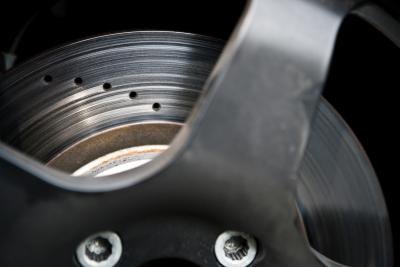Thursday, October 17, 2013
Can You Re Use The Brake Pads From A Bad Rotor

For most people, a "bad" brake rotor is one with a few scratches and grooves in the surface that cut into the pad, or one thats wavy and warped. But theres a lot more going on with your brake rotors than you might see on the surface -- and even thats bad enough as it is.
What is a "Bad" Rotor?
A lot of things can go wrong with a brake rotor. Most obvious are mechanical faults like grooves in the rotor caused by harder particulates in the pad material, cracks in the rotor and waviness or warping in the rotor surface. A front brake rotor must regularly absorb about 30 to 35 percent of all of the energy that goes into moving your car, which creates a lot of heat. Heat, among other things, causes the rotors metal to expand; when the metal cools and contracts, certain zones in the metal will cool faster than others. The uneven cooling pull those zones in different directions, causing the rotor surface to warp and become wavy. Extreme heating can also affect the metals crystalline structure, causing even bigger long-term problems.
Grooved Rotors
All brake rotors that arent brand-new exhibit a certain amount of grooving on the rotor surface. When the grooves are microscopically small, the peaks between the grooves will cut into the brake pad material. Simultaneously, the harder particles in the pad will resist this cutting and abrade the sides of those grooves. Eventually, the grooves will get large enough to be visible and cut large, matching grooves in the pad. So, its not a matter of if the grooved rotor will cut into your pad -- and vice versa -- but rather how far and how much the pads will deepen those grooves. If the rotors dont exhibit grooves deep or sharp enough to catch a fingernail, then you can replace the pads without machine-work or replacement. You can put new pads on a deeply-grooved rotor, but bear in mind that a) it will take some time for the pads to "bed in" and conform to the grooves in the rotor, b) while bedding in, the pads will rapidly accelerate groove widening and c) grooves create weak points in the rotor, increasing the odds that it will crack or shatter.
Warping
A warped rotor could easily eat your new pads alive, and may damage other, more expensive parts in the brake system. This is particularly true for some cars with antilock braking systems. An ABS system works by boosting or dropping brake pressure to each wheel. If the crests of the waves in your rotor are further apart than the pad is long, then the entire pad will drop in between the waves. When the crests come along, theyll shove backward on the pad, creating tiny fluid pressure fluctuations in the brake lines. These oscillations can damage the antilock brake pressure modulator, which costs far more to replace than itll cost you to have the rotors machined flat. So, if your rotors are warped, new rotors are advisable, particularly since new rotors arent usually much more expensive than machining. And, after machining, youll wind up with thinner rotors that are more prone to overheating and structural failure.
Material Changes
This little-known, but endemic, problem has both plagued and bewildered brake mechanics for a century or more. Long ago, mechanics noticed that, after the rotors for warpage or overheating, cars would often roll back into the shop when the rotors re-warped a few months later. And the re-warping problem has existed as alternately a puzzle or a myth -- depending upon who you asked -- since then. But, fairly recently, engineers have discovered that, following an episode of extreme overheating, the areas of the rotor that got the hottest would change in crystalline structure from the normal ferrite structure to the far harder cementite. Cementite, also known as iron carbide, is much like a ceramic and has far different properties in terms of hardness, abrasiveness and thermal conductivity. Think of chunks of oak floating in frozen ice cream, and youve got the right idea. Once these cementite spots form and penetrate the rotor surface to more than a few nanometers, the rotor is shot and will quickly self-destruct.